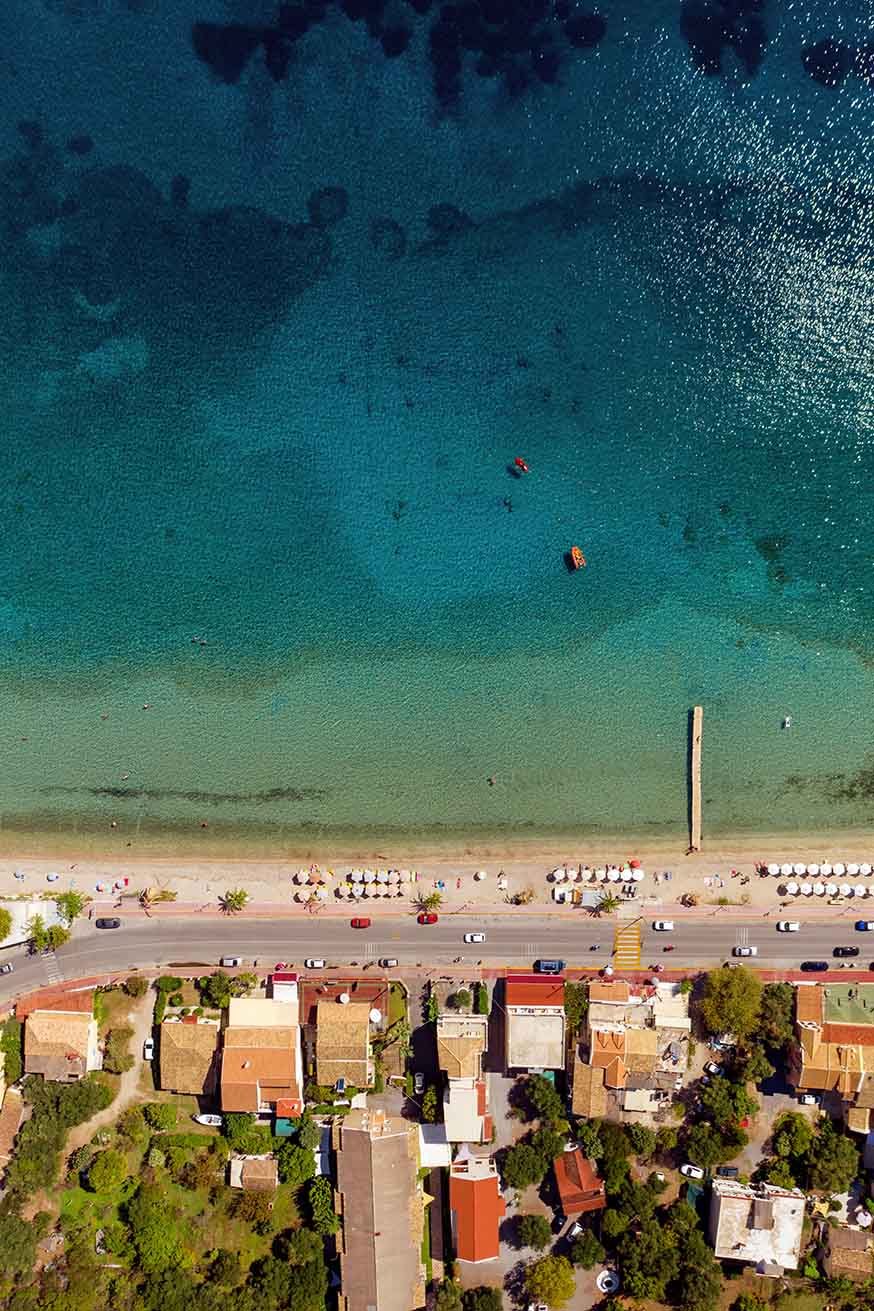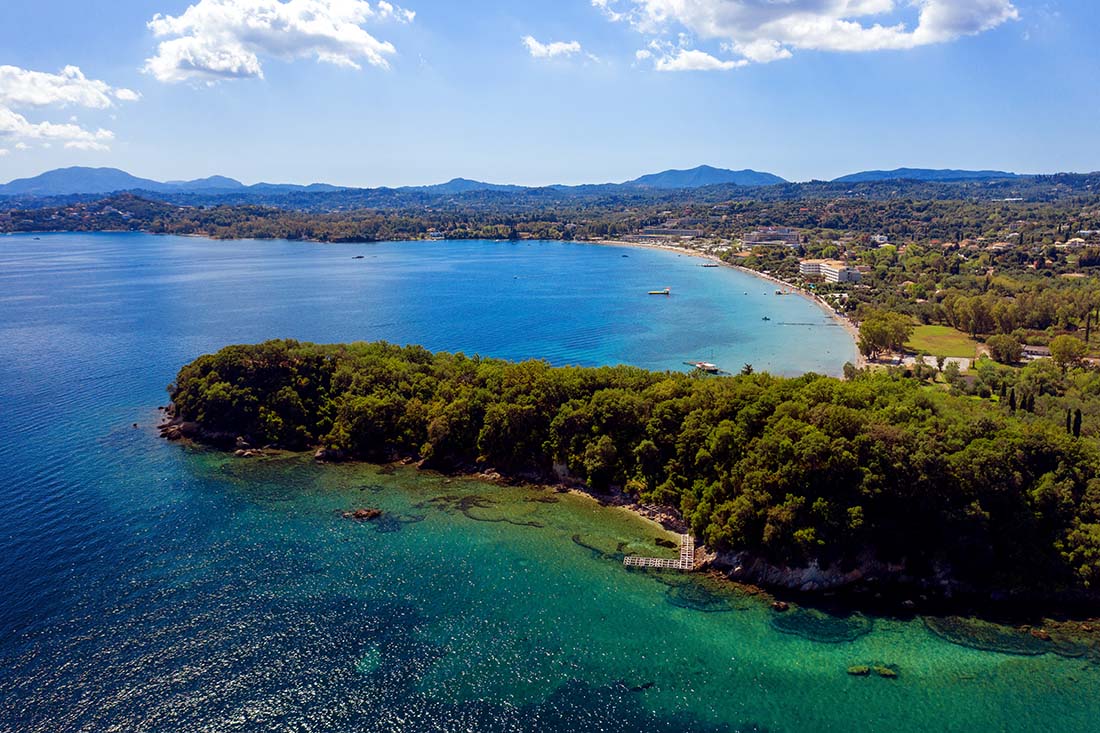The tourist area of Dassia is one of the most popular destinations on Corfu and extends over the homonymous beach with blue shallow waters. It is located about 12 km from the centre, between the two east coast tourist villages of Gouvia and Ipsos. It is an ideal choice for young people and families as it is in close proximity to the city and serves every need from accommodation to entertainment.
It has regular transport to Corfu Town, with buses running half-hourly in summer, from morning to night. For more autonomous travel, car hire is available with various rental options.
Accommodation & Catering at Dassia
Dassia has a wide range of tourist accommodation, such as large hotels of non-inclusive and all-inclusive nature, holiday apartments, studios and camping grounds.
The main road is a long strip development comprising hotels, bars, various kinds of shops, tavernas, restaurants and snack bars with Corfiot and international cuisine.
Dassia is also famous for its nightlife with many bars on the beach and bars and clubs around the resort.
Dassia Beach
Dassia has one of the largest and liveliest beaches on the island. This 2 kilometre long sand and shingle beach’s azure, shallow water is often warmer than most beaches on Corfu. There are sunbeds and umbrellas for rent along most of the length of the beach. A safe beach for children, it also appeals to couples and families who enjoy water sport as it offers water skiing and parasailing.
Dassia Sights
The traditional villages near Dassia, are worth a visit for the charm of their narrow streets, the old mansions, and in the case of Kato Korakiana, for the medieval tower of the village. Each village has its own individual appeal, legends and traditions. It is a trip back in time to a bygone era.
There is also a branch of the National Gallery of Corfu which has a permanent exhibition of works from the first post-Byzantine years to modern art of the last decade, which highlight the evolution of Modern Greek painting. Periodic exhibitions and events are also organized.
The history of Club Mediteranee
“It was essentially a pioneering holiday formula based on outdoor life, sports, changing scenery, meeting, pleasure, as part of a stay “that will implement a hedonistic perception of leisure with the game as its ultimate goal” (Bertrand Réau).
Club Med was a ‘vacation village’ concept introduced to the international tourism market by a French company in the 1950’s. By selecting specific criteria they provided guests with a full package holiday i.e. sports activities, cruises, events, cuisine with unique flavors for that time and other innovative activities. The first Club Med opened in Mallorca in 1950.
Dassia, on Corfu, was chosen as a Club Med destination as it was characterized as a small “paradise” in an exotic part of the Mediterranean. Club Med was the first international ‘tourist village’ built on the island with the first international charters arriving in 1972. It was the forefather of the all-inclusive hotels which have gained such popularity on the island today.
The history of the Merlin estate
In Dassia, there is a verdant area known as the Merlin Estate, named after the affluent, Merlin family it belonged to. Charles Merlin’s heir, his son, English Lord Sidney Merlin, a botanist, in 1918 sold a huge area in Lamia and settled on his estate on Corfu.
In 1925 he introduced an American variety of orange called “Washington Navel” which was consequently dubbed “Merlin”, by which moniker it is still known today. He also introduced the Kumquat from Japan to Corfu, from which the famous Corfiot sweet, preserve and liqueur is made, which everyone purchases, as it is specific to the island.
In the area that stretches to the sea, separated by a small river, is the abandoned Merlin mansion, which went on the market in 2018. The estate played an important role in the economy of Corfu, as it was the only orange grove for the aforementioned variety of orange and gave work to many locals.
A point to ponder is that, if Merlin did not leave Lamia, perhaps the variety of ‘Merlin’ and ‘Kumquat’ would be products of Lamia and not of Corfu?
Source
LIFO | ΑΛΜΑΝΑΚ (2018). “Club Med“, https://www.lifo.gr/articles/almanac/206388/club-med
CORFUTV NEWS (2019). “Σε ελληνικά χέρια μέσω… αμερικανικού fund το πρώην Club Med στην Κέρκυρα“, https://corfutvnews.gr/se-ellinika-cheria-meso-amerikanikou-fund-to-proin-club-med-stin-kerkyra/
ΜΗΧΑΝΗ ΤΟΥ ΧΡΟΝΟΥ. “Ποια ήταν η οικογένεια Μέρλιν που έδωσε το όνομά της στην ποικιλία πορτοκαλιών και έφερε το κουμ κουάτ στην Κέρκυρα. Από μια σύμπτωση δεν έγιναν προϊόντα Λαμίας…“, https://www.mixanitouxronou.gr/poia-itan-i-oikogeneia-merlin-edose-to-onoma-tis-stin-poikilia-portokalion-kai-efere-to-koum-kouat-stin-kerkyra-apo-mia-sybtosi-den-eginan-proionta-lamias/
ΕΘΝΙΚΗ ΠΙΝΑΚΟΘΗΚΗ. “Παράρτημα Κέρκυρας“, http://corfu.nationalgallery.gr/parartema-kerkyras-plerophories








Discussion